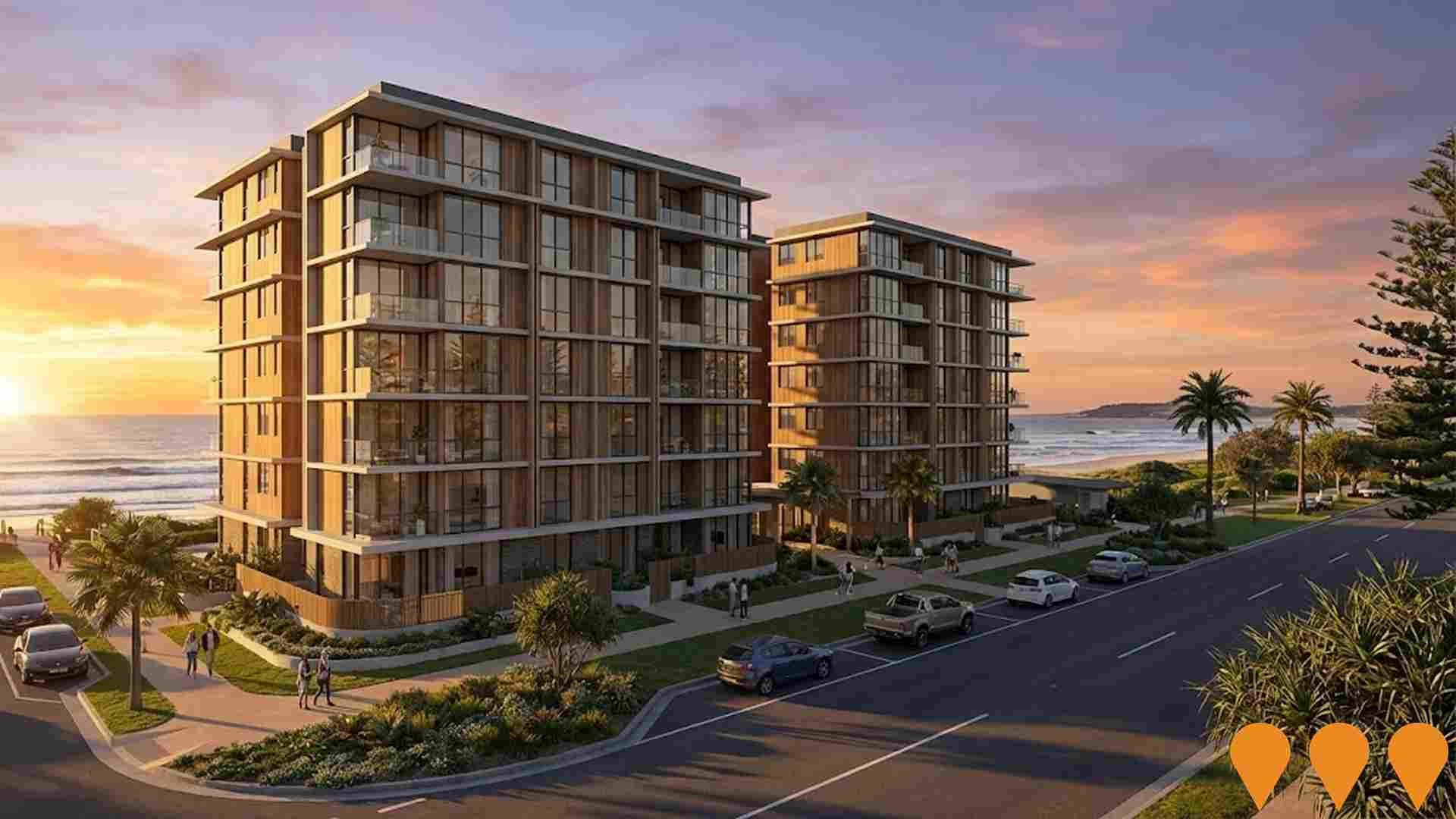Chart Color Schemes
est. as @ -- *
ABS ERP | -- people | --
2021 Census | -- people
Sales Activity
Curious about local property values? Filter the chart to assess the volume and appreciation (including resales) trends and regional comparisons, or scroll to the map below view this information at an individual property level.
Find a Recent Sale
Sales Detail
Population
An assessment of population growth drivers in Coramba - Nana Glen - Bucca reveals an overall ranking slightly below national averages considering recent, and medium term trends
Coramba - Nana Glen - Bucca's population is 4,073 as of Nov 2025. This figure reflects an increase of 123 people since the 2021 Census, which recorded a population of 3,950. The growth is inferred from ABS estimates: 4,049 in June 2024 plus 18 new addresses validated since the Census date. This results in a density ratio of 11.2 persons per square kilometer. Coramba - Nana Glen - Bucca's 3.1% population growth since census is close to the SA3 area's 4.2%, indicating competitive growth fundamentals. Natural growth contributed approximately 57.0% of overall population gains recently.
AreaSearch uses ABS/Geoscience Australia projections for each SA2 area, released in 2024 with a base year of 2022. For areas not covered by this data, NSW State Government's SA2 level projections are used, released in 2022 with a base year of 2021. Growth rates by age group from these aggregations are applied to all areas for years 2032 to 2041. Based on projected demographic shifts, the area is expected to grow by 163 persons to 2041, recording a gain of 3.4% over the 17-year period.
Frequently Asked Questions - Population
Development
AreaSearch assessment of residential development drivers sees a low level of activity in Coramba - Nana Glen - Bucca, placing the area among the bottom 25% of areas assessed nationally
Coramba - Nana Glen - Bucca has recorded approximately six residential property approvals annually over the past five financial years, totalling thirty homes. In FY26 so far, zero approvals have been recorded. On average, 2.2 people moved to the area per new home constructed between FY21 and FY25, reflecting strong demand that supports property values. New homes are being built at an average expected construction cost of $344,000.
This year, $447,000 in commercial approvals have been registered, indicating a predominantly residential focus. Compared to the rest of NSW, Coramba - Nana Glen - Bucca records significantly lower building activity, 64.0% below the regional average per person. This limited new supply generally supports stronger demand and values for established dwellings. Development activity is also lower than the national average, suggesting market maturity and potential development constraints. Recent development has consisted entirely of detached houses, preserving the area's low density nature and attracting space-seeking buyers.
The estimated population count per dwelling approval is 2311 people, reflecting a quiet, low activity development environment. Future projections indicate Coramba - Nana Glen - Bucca adding 139 residents by 2041. At current development rates, new housing supply should comfortably meet demand, providing good conditions for buyers and potentially supporting population growth beyond current projections.
Frequently Asked Questions - Development
Infrastructure
Coramba - Nana Glen - Bucca has emerging levels of nearby infrastructure activity, ranking in the 26thth percentile nationally
Changes to local infrastructure significantly affect an area's performance. AreaSearch has identified 16 projects that may impact the region. Notable ones include North Boambee Valley (East) Release Area, The Shoreline Luxury Retirement Living, Elements at Coffs, and Ocean Parade Apartments. The following list details those most likely to be relevant.
Professional plan users can use the search below to filter and access additional projects.
INFRASTRUCTURE SEARCH
 Denotes AI-based impression for illustrative purposes only, not to be taken as definitive under any circumstances. Please follow links and conduct other investigations from the project's source for actual imagery. Developers and project owners wishing us to use original imagery please Contact Us and we will do so.
Denotes AI-based impression for illustrative purposes only, not to be taken as definitive under any circumstances. Please follow links and conduct other investigations from the project's source for actual imagery. Developers and project owners wishing us to use original imagery please Contact Us and we will do so.
Frequently Asked Questions - Infrastructure
Pacific Bay Resort Studios & Village
A $438 million fully integrated feature film production and post-production complex situated on 100 acres. The precinct will include sound stages, workshops, a hotel, an Olympic museum, an art gallery, and educational facilities. In August 2025, the NSW Government announced $5.5 million in funding for a noise wall to mitigate impacts from the Coffs Harbour Bypass, allowing the project to proceed with updated planning requirements.
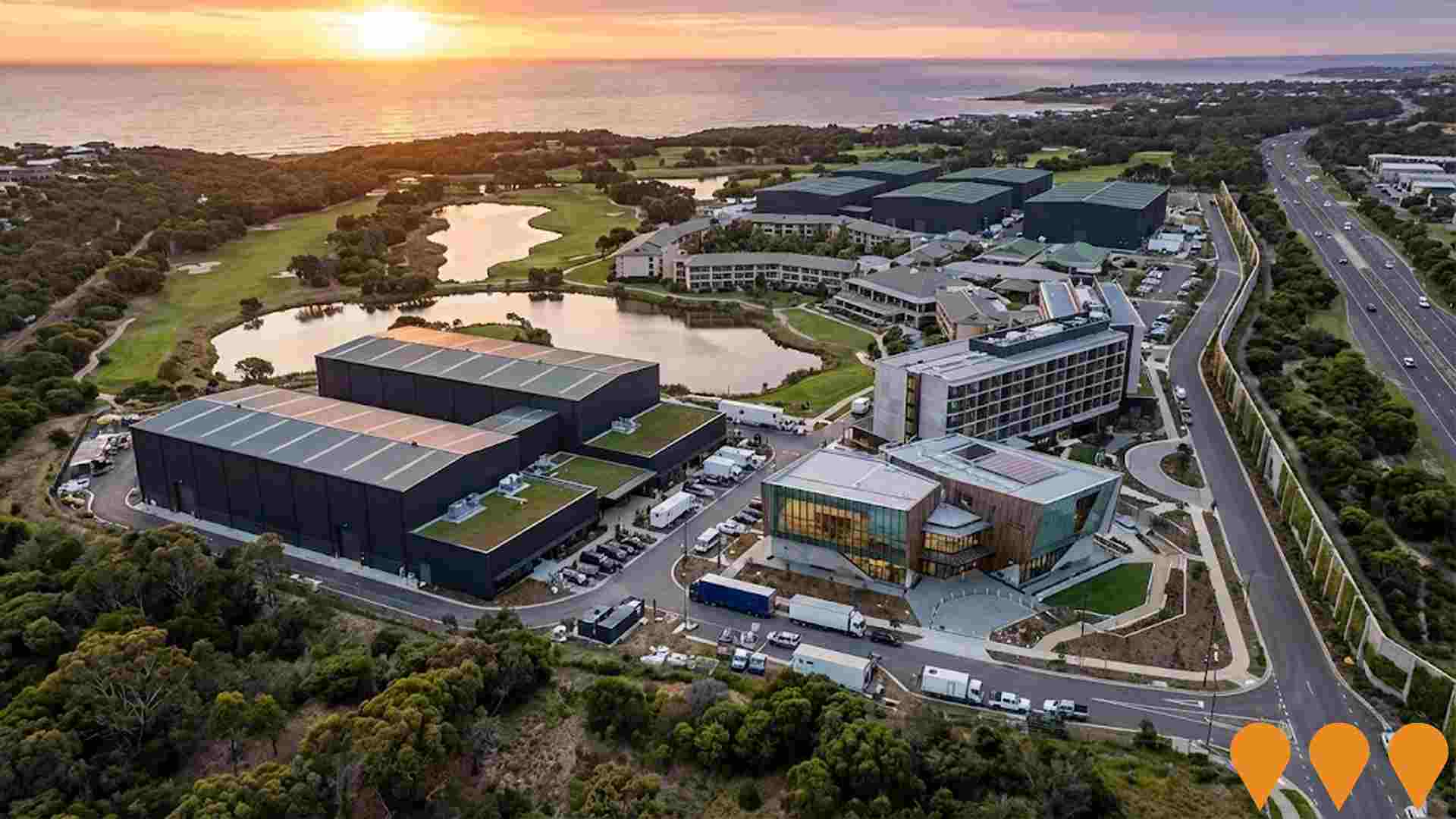
The Shoreline Luxury Retirement Living
A $150-million luxury retirement and residential aged care village featuring 185 architecturally-designed independent living apartments, terraces and villas, plus a 120-bed premium residential aged care home. Resort-style facilities include a swimming pool, cafe, bowling green, community gardens, Bombora Bar, and comprehensive recreation facilities in a secure gated community. First stages opened in October 2022, with ongoing staged construction. As of November 2025, the project is nearing final stages and remains on track for full completion in early 2027.

Coffs Harbour Jetty Foreshore Precinct Revitalisation
A comprehensive community-led revitalisation of the historic Coffs Harbour Jetty Foreshore precinct, creating a vibrant mixed-use area with up to 250 residential dwellings, 200 short-stay tourist accommodation units, commercial/retail spaces, tourism facilities, enhanced public open spaces, and building heights of 2-6 storeys. Informed by over 3,600 public submissions, the project emphasises connection to Country, cultural significance for the Gumbaynggirr people, and reinvestment of all revenue into parklands and community facilities. Public exhibition closed 30 June 2025; currently under assessment by the Department of Planning, Housing and Infrastructure.
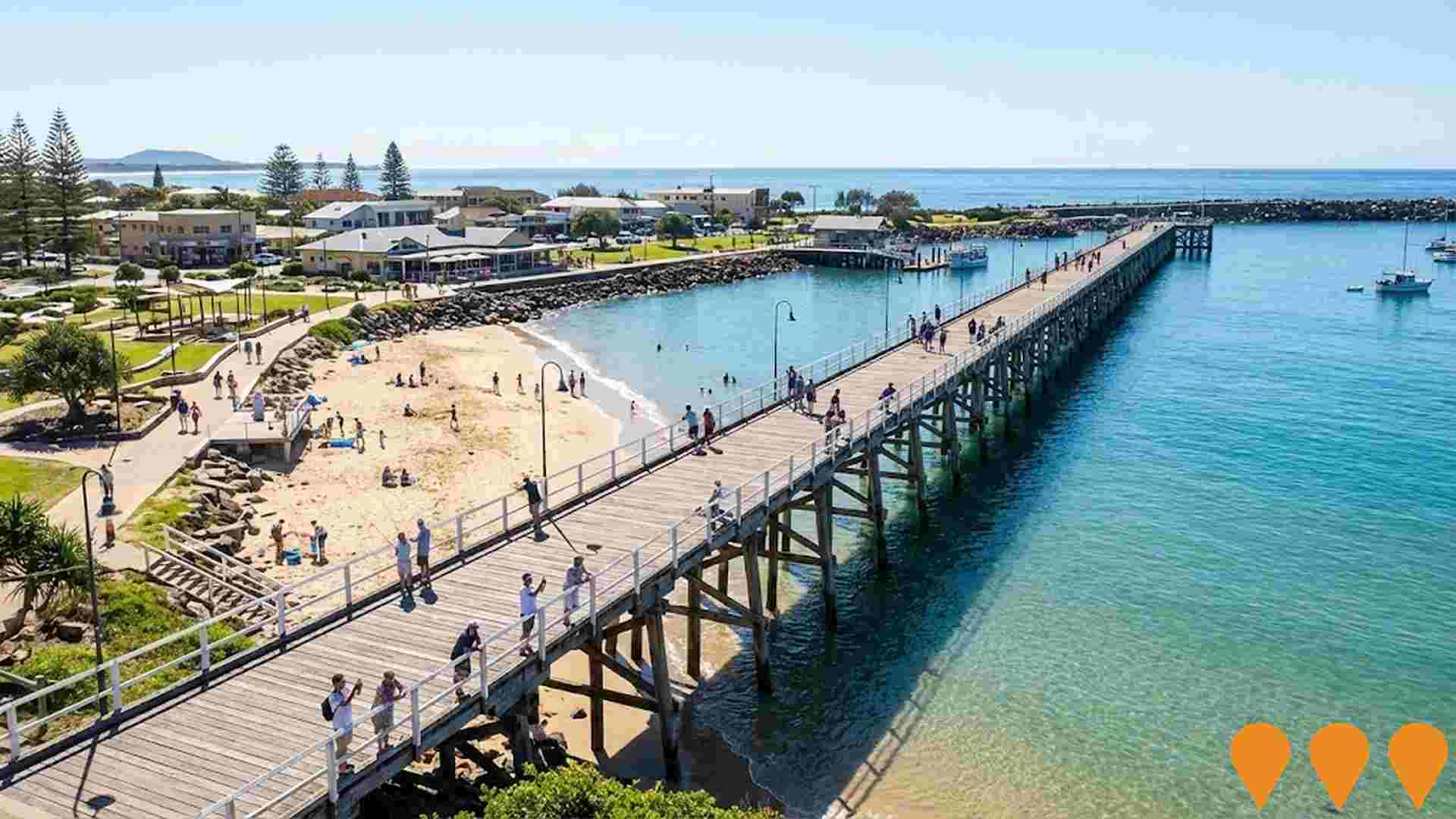
Coffs Harbour Airport Enterprise Park
A 43-hectare subdivision adjacent to Coffs Harbour Airport, designed to attract a mixture of business, aviation-related, high-tech, and industrial enterprises. The development provides fully serviced lots with roads, drainage, water, sewer, electricity, and telecommunications. Phase 1 was completed in early 2021 with initial lots released; subsequent stages remain under construction with ongoing rezoning and development works as of late 2025.

Coffs Harbour Health Campus Expansion
Stage 2 redevelopment including new emergency department, intensive care unit, coronary care unit, medical imaging, pathology, pharmacy, 102 inpatient beds across four wards, ambulatory care centre, allied health services, expanded mental health unit, and multi-storey car park.

Coffs Harbour Bypass
A $2.2 billion, 14-kilometre four-lane bypass of Coffs Harbour, jointly funded by the Australian and NSW governments. Includes three tunnels (Roberts Hill, Gatelys Road, and Shephards Lane), approximately 12 km of new highway and 2 km of upgraded highway. Will remove around 12,000 vehicles per day from the Coffs Harbour CBD, improve road safety, boost freight efficiency, and save motorists approximately 12 minutes in travel time.
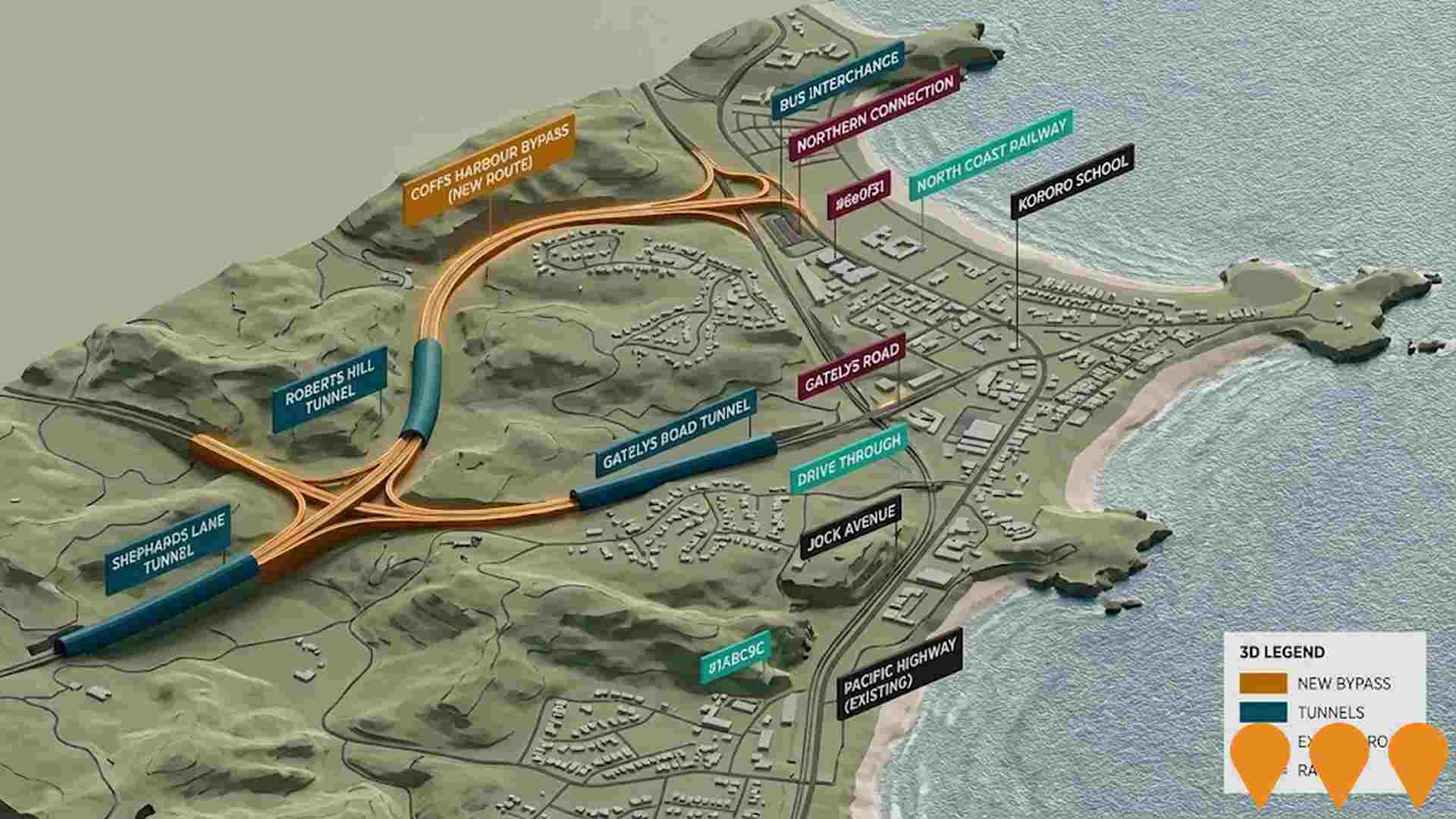
Elements at Coffs
A quality residential land release estate on the eastern side of the Pacific Highway offering generous reserves and open spaces for designing dream homes. Located conveniently near the airport, health campus, education facilities, and shopping centres. The development features multiple stages with Stage 4 currently selling, positioned halfway between Coffs Harbour and Sawtell.
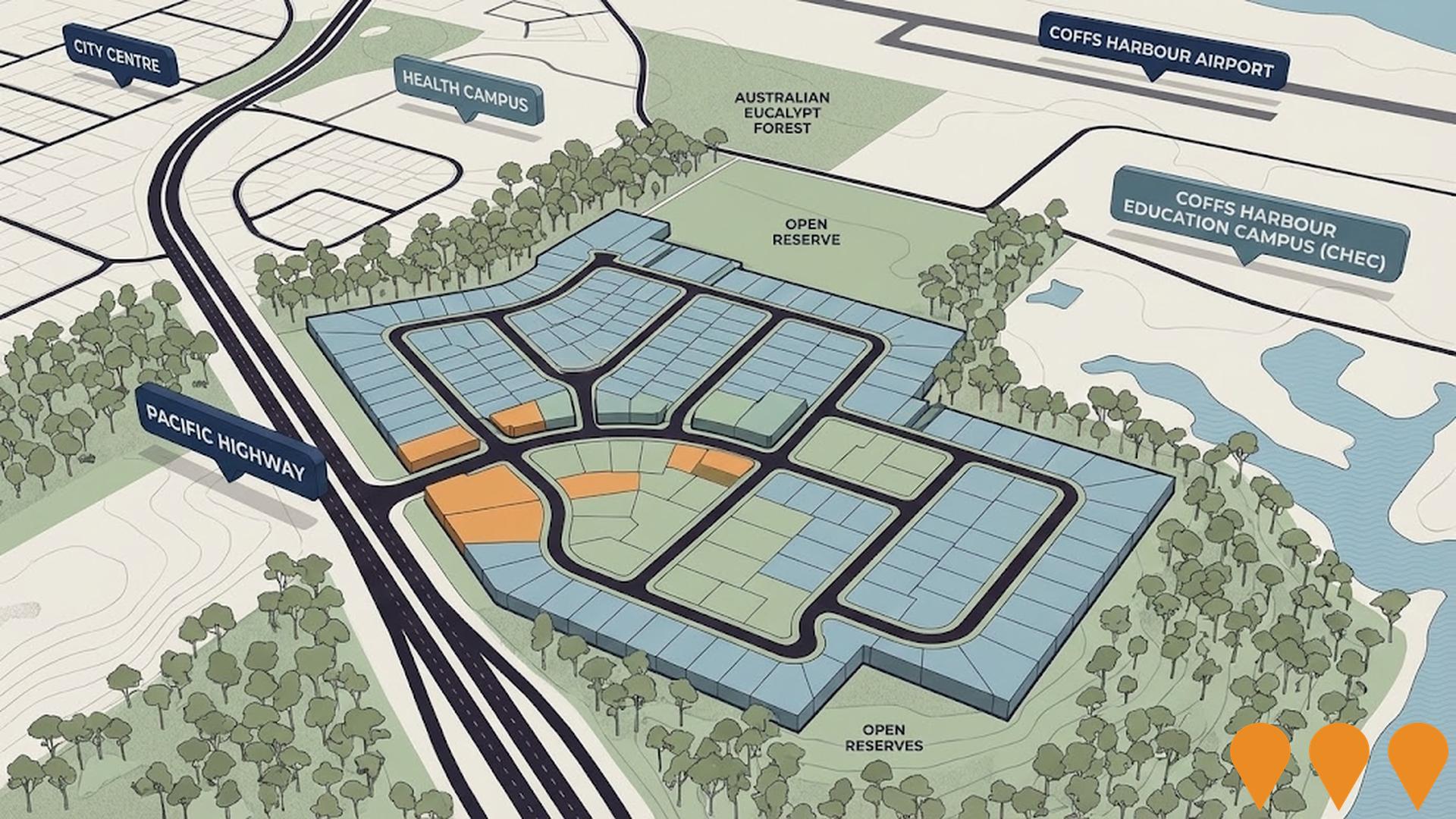
Coffs Harbour Affordable Housing
State Significant Development (SSD-83294209) by Homes NSW for a four-storey residential flat building containing 60 high-quality social and affordable housing units, including a communal room, basement car parking (approx. 29 spaces), internal lifts, landscaping and fencing. The project is located close to schools, shops, medical facilities and public transport, and will help rehouse residents displaced by other redevelopments. The application was exhibited October 2025 and is currently in the Response to Submissions / Assessment phase with the Department of Planning, Housing and Infrastructure.
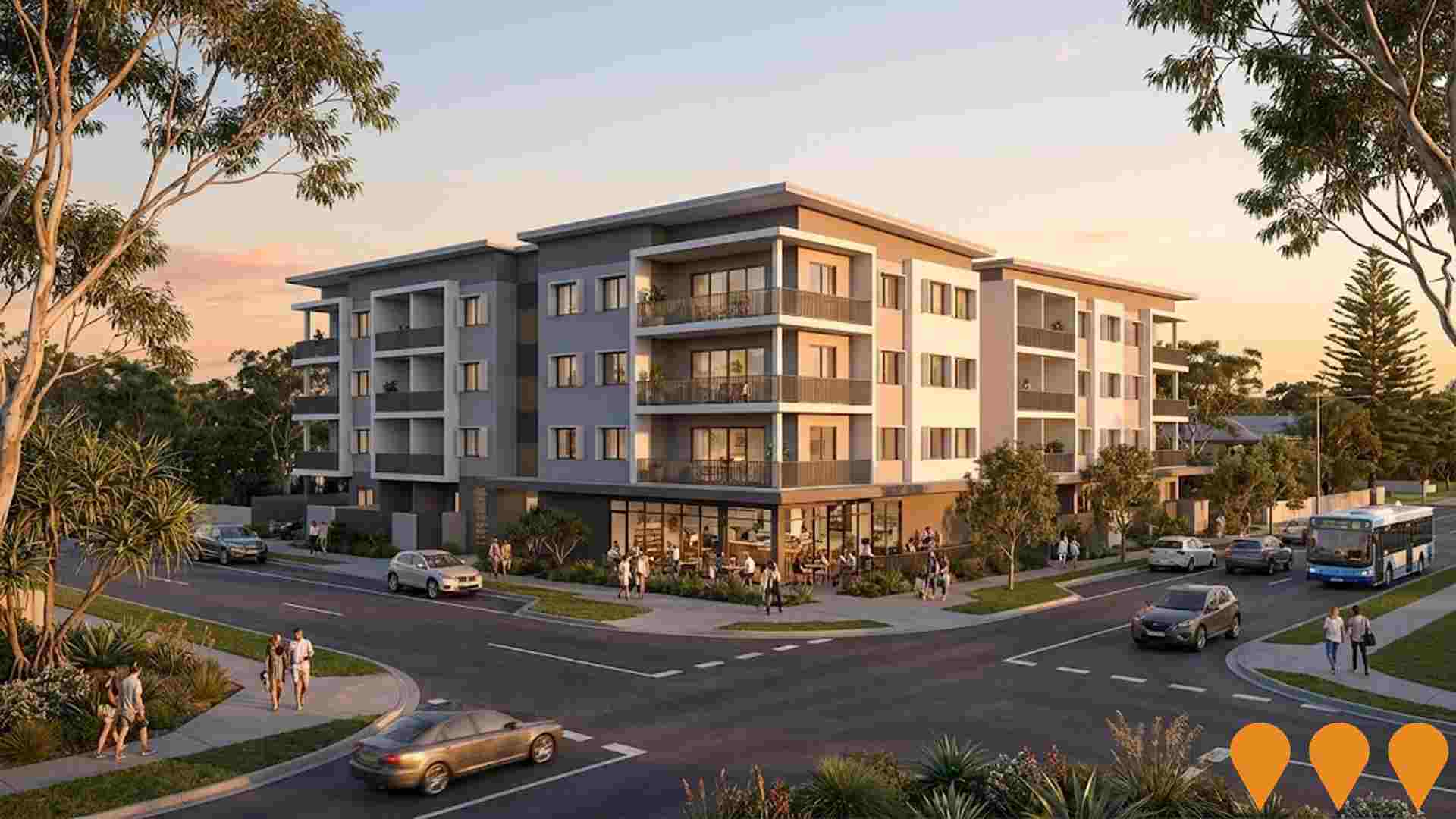
Employment
Coramba - Nana Glen - Bucca has seen below average employment performance when compared to national benchmarks
Coramba-Nana Glen-Bucca has a skilled workforce with an unemployment rate of 4.0% as of June 2025. The area experienced estimated employment growth of 1.7% over the past year.
There are 1,962 residents in work, with an unemployment rate of 4.1%, 0.4% higher than the Rest of NSW's rate of 3.7%. Workforce participation is at 60.4%, compared to the regional average of 56.4%. The leading employment industries among residents are health care & social assistance, construction, and retail trade. Construction shows strong specialization with an employment share 1.5 times the regional level, while manufacturing has limited presence at 3.7% compared to the regional average of 5.8%.
Employment opportunities locally appear limited based on Census data analysis. Over a 12-month period ending June 2025, employment increased by 1.7%, labour force grew by 3.3%, leading to an unemployment rate rise of 1.5 percentage points. In comparison, Rest of NSW saw employment decline by 0.1%, labour force growth of 0.3%, and a 0.4% increase in unemployment. National employment forecasts from Jobs and Skills Australia, issued May 2025, project national employment growth of 6.6% over five years and 13.7% over ten years. Applying these projections to Coramba-Nana Glen-Bucca's employment mix suggests local growth of approximately 6.5% over five years and 13.5% over ten years.
Frequently Asked Questions - Employment
Income
The area's income profile falls below national averages based on AreaSearch analysis
Coramba-Nana Glen-Bucca had a median taxpayer income of $50,598 and an average income of $64,418 in the financial year 2022, according to postcode level ATO data aggregated by AreaSearch. This is roughly equivalent to the national average, compared to Rest of NSW's median income of $49,459 and average income of $62,998. By September 2025, estimated incomes would be approximately $56,978 (median) and $72,541 (average), based on a 12.61% increase since financial year 2022. The 2021 Census showed household, family, and personal incomes in Coramba-Nana Glen-Bucca ranked modestly, between the 33rd and 46th percentiles. Income brackets indicated that 36.5% of individuals (1,486 people) fell within the $1,500-$2,999 range, similar to surrounding regions where 29.9% occupied this range. After housing costs, 85.9% of income remained for other expenses. The area's SEIFA income ranking placed it in the 5th decile.
Frequently Asked Questions - Income
Housing
Coramba - Nana Glen - Bucca is characterized by a predominantly suburban housing profile, with ownership patterns similar to the broader region
The dwelling structure in Coramba - Nana Glen - Bucca, as per the latest Census, consisted of 96.5% houses and 3.5% other dwellings (semi-detached, apartments, 'other' dwellings), compared to Non-Metro NSW's 78.4% houses and 21.6% other dwellings. Home ownership in Coramba - Nana Glen - Bucca was at 39.4%, with mortgaged dwellings at 43.9% and rented ones at 16.7%. The median monthly mortgage repayment was $1,733, aligning with the Non-Metro NSW average, while the median weekly rent figure was $365, compared to Non-Metro NSW's $370. Nationally, Coramba - Nana Glen - Bucca's mortgage repayments were lower than the Australian average of $1,863, and rents were less than the national figure of $375.
Frequently Asked Questions - Housing
Household Composition
Coramba - Nana Glen - Bucca features high concentrations of family households, with a higher-than-average median household size
Family households constitute 80.2% of all households, including 35.3% couples with children, 34.7% couples without children, and 9.8% single parent families. Non-family households account for the remaining 19.8%, with lone person households at 17.0% and group households comprising 2.8%. The median household size is 2.7 people, larger than the Rest of NSW average of 2.4.
Frequently Asked Questions - Households
Local Schools & Education
Educational outcomes in Coramba - Nana Glen - Bucca fall within the lower quartile nationally, indicating opportunities for improvement in qualification attainment
The area faces educational challenges, with university qualification rates at 20.1%, significantly lower than the NSW average of 32.2%. This presents both a challenge and an opportunity for targeted educational initiatives. Bachelor degrees are most prevalent at 14.4%, followed by postgraduate qualifications (3.6%) and graduate diplomas (2.1%). Trade and technical skills are prominent, with 47.0% of residents aged 15+ holding vocational credentials - advanced diplomas (11.3%) and certificates (35.7%).
Educational participation is high, with 29.6% of residents currently enrolled in formal education. This includes 11.3% in primary education, 9.1% in secondary education, and 2.6% pursuing tertiary education. Coramba - Nana Glen - Bucca's 4 schools have a combined enrollment of 209 students, focusing exclusively on primary education with secondary options available nearby. The area has limited local school capacity (5.1 places per 100 residents vs 15.6 regionally), leading many families to travel for schooling.
Frequently Asked Questions - Education
Schools Detail
Nearby Services & Amenities
Transport
Transport servicing is low compared to other areas nationally based on assessment of service frequency, route connectivity and accessibility
Coramba-Nana Glen-Bucca region has 193 active public transport stops. These are served by buses along 19 different routes, offering 185 weekly passenger trips in total. Residents enjoy good transport accessibility, with an average distance of 217 meters to the nearest stop.
On average, there are 26 bus trips daily across all routes, resulting in about zero weekly trips per individual stop.
Frequently Asked Questions - Transport
Transport Stops Detail
Health
Coramba - Nana Glen - Bucca's residents are relatively healthy in comparison to broader Australia with a fairly standard level of common health conditions seen across both young and old age cohorts
Coramba-Nana Glen-Bucca's health metrics closely align with national benchmarks. Common health conditions are seen across both young and old age cohorts at a standard level.
Private health cover is held by approximately 52% of the total population (~2,113 people), slightly higher than the average SA2 area rate of 48.0%. The most prevalent medical conditions are mental health issues affecting 8.9% of residents and arthritis impacting 8.6%. A total of 68.5% report being completely free from medical ailments compared to 63.9% across Rest of NSW. The area has 19.0% of residents aged 65 and over (773 people), lower than the 23.9% in Rest of NSW. Health outcomes among seniors are notably strong, outperforming those of the general population in health metrics.
Frequently Asked Questions - Health
Cultural Diversity
Coramba - Nana Glen - Bucca is considerably less culturally diverse than average when assessed alongside AreaSearch's national rankings for language and cultural background related metrics
Coramba-Nana Glen-Bucca had a cultural diversity below average, with 89.3% of its population being citizens born in Australia speaking English only at home (88.0%, 95.1% respectively). Christianity was the predominant religion, comprising 45.6%. The most notable overrepresentation was in 'Other', with 0.8% compared to Rest of NSW's 3.3%.
Top ancestry groups were Australian (32.4%), English (31.4%), and Irish (8.2%). Dutch (1.9%) and German (4.4%) were notably overrepresented, while Russian showed a slight increase from regional average (0.4% vs 0.2%).
Frequently Asked Questions - Diversity
Age
Coramba - Nana Glen - Bucca hosts an older demographic, ranking in the top quartile nationwide
Coramba-Nana Glen-Bucca's median age of 44 years is similar to Rest of NSW's 43 years and above the national average of 38 years. Compared to Rest of NSW, Coramba-Nana Glen-Bucca has a higher percentage of residents aged 45-54 (14.9%) but fewer residents aged 75-84 (4.8%). Between the 2021 Census and now, the population aged 85+ has grown from 0.8% to 1.6%. Conversely, the percentage of residents aged 55-64 has decreased from 16.6% to 15.4%, and the percentage of those aged 5-14 has dropped from 13.9% to 12.8%. By 2041, Coramba-Nana Glen-Bucca is projected to see significant shifts in its age composition. The 35-44 age group is expected to grow by 15%, reaching 552 people from 479. Meanwhile, the populations aged 85+ and 15-24 are anticipated to decrease.




